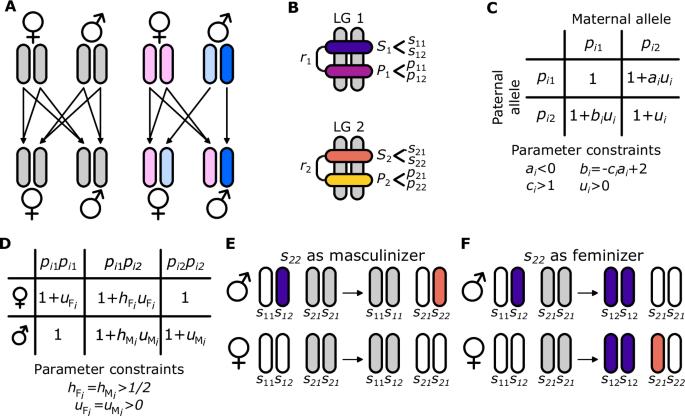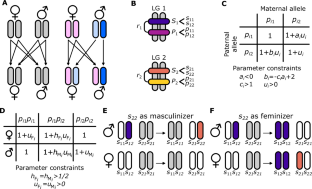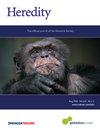通过亲子关系和性对抗实现性别决定机制的转变
IF 3.9
2区 生物学
Q2 ECOLOGY
引用次数: 0
摘要
性染色体携带决定性别的基因座,因此它们在雌性和雄性之间的传递方式不同。这些差异导致它们以不同的方式被选择,因此预测它们会富集性对抗基因和亲代对抗基因。性拮抗基因对雌性和雄性的适合度效应是相反的;亲代拮抗基因在母系遗传和父系遗传时的适合度效应也是相反的。性别拮抗选择可以推动性别决定的转变,即一对常染色体变成一对性染色体,以取代祖先的性染色体。亲代拮抗选择是否同样能驱动性别决定的转变,目前仍是未知数。与性拮抗选择相比,我提出了一个模型来研究通过亲本拮抗选择实现性别决定转变的可能性。该模型假定一个祖先性染色体性别决定基因座与一个亲代或性代拮抗基因相连,以及一个常染色体亲代或性代拮抗基因,在该基因附近出现了一个新的性别决定基因。我发现,当新型性别决定基因的入侵涉及从雄性异配到雌性异配(或反之)的过渡时,亲本拮抗选择可以促进新型性别决定基因的传播,并保持祖先的性别决定基因,这与性拮抗选择类似。然而,当祖先的性别决定基因位点与亲代拮抗基因位点相连时,雌雄异配的过渡就更有可能发生。因此,亲本拮抗选择可以促成一些非常不寻常的进化模式,而这些模式在其他性别决定的进化模式中是不会遇到的。这些结果提供了新的见解,让我们了解为什么某些性别决定机制在进化过程中会如此不稳定。本文章由计算机程序翻译,如有差异,请以英文原文为准。


Transitions in sex determination mechanisms through parental and sexual antagonism
Sex chromosomes carry the sex-determining locus, causing them to be differently transmitted to and from females and males. These differences lead them to be selected upon in different ways, and hence they are predicted to become enriched for sexually- and parentally-antagonistic genes. Sexually-antagonistic genes have opposing fitness effects in females versus in males; parentally-antagonistic genes have opposing fitness effects when inherited maternally versus paternally. Sexually-antagonistic selection can drive sex determination transitions, whereby an autosome pair becomes a sex chromosome pair in lieu of the ancestral sex chromosomes. Whether parentally-antagonistic selection can similarly drive sex determination transitions remains unknown. I present a model to investigate the potential for transitions in sex determination through parentally-antagonistic selection as compared to sexually-antagonistic selection. This model assumes an ancestral sex-chromosomal sex-determining locus linked to a parentally- or sexually-antagonistic gene, and an autosomal parentally- or sexually-antagonistic gene in whose vicinity a novel sex-determining gene arises. I find that parentally-antagonistic selection can promote the spread of novel sex-determining genes as well as maintain ancestral sex-determining genes when the invasion of the novel sex-determining gene would involve transitions from male to female heterogamety (or vice versa), similar to sexually-antagonistic selection. Transitions between male and female heterogamety are, however, more likely when the ancestral sex-determining locus is linked to a parentally-antagonistic locus. Consequently, parentally-antagonistic selection can enable some highly unusual evolutionary patterns not encountered in other evolutionary models of sex determination. These results provide novel insights into why some sex-determining mechanisms may be so evolutionary labile.
求助全文
通过发布文献求助,成功后即可免费获取论文全文。
去求助
来源期刊

Heredity
生物-进化生物学
CiteScore
7.50
自引率
2.60%
发文量
84
审稿时长
4-8 weeks
期刊介绍:
Heredity is the official journal of the Genetics Society. It covers a broad range of topics within the field of genetics and therefore papers must address conceptual or applied issues of interest to the journal''s wide readership
 求助内容:
求助内容: 应助结果提醒方式:
应助结果提醒方式:


